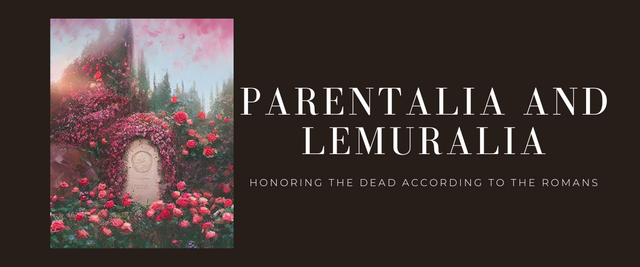Lemuralia and Parentalia: honoring the dead according to the Romans
Author's note: The following article was published on Spanish language in November 4th, 2022, in my Blurt blog.
 Banner made with Canva; image created with Starryai
Banner made with Canva; image created with Starryai
On November 1st and 2nd, the Day of the Dead is celebrated in different parts of Latin America. On both dates we can see entire families go to the cemeteries to clean and decorate the tombs of their loved ones or, in their homes, erect altars full of the dishes and sweets that were once enjoyed in life by those who are no longer there with them.
These types of celebrations have occurred in different cultures since inmemorial times. Examples can be found in the Mesoamerican, Scandinavian and Celtic peoples. The Mesoamerican peoples, particularly the Aztecs, celebrated the Miccailhuitontli precisely on the first two days of November; during these festivities a series of rituals were performed, from dances to presentation of offerings to the deceased. For their part, the Scandinavians honored their dead by burying or cremating them in funeral ships; offerings and articles that were used by the deceased when they lived were placed in them.
During the Samhain celebrations, the Celts used to leave food outside their houses as a way of pleasing the spirits of the deceased and obtaining protection from them, because if they were not paid due attention they would return as vengeful beings that would bring misfortune to the land. family (GM, 2022).
Two similar festivities can be found in Roman culture, the Parentalia and the Lemuralia, where various religious practices were carried out with the intention of maintaining a cordial and peaceful relationship with the spirits of the dead.
The Parentalia
According to Robert Schilling (1995) and Mchel Meslin (2003), the Parentalia was a nine-day celebration, during which the Romans honored their deceased relatives, who were called manes or parentes. These festivities were celebrated from February 13th to 21st. On the first day, a funeral sacrifice was performed led by a vestal virgin. In the days that followed, Roman families made visits to the graves of their deceased, bringing with them offerings such as oats, salt, wine, bread, milk, and honey. The celebrations ended on February 21 with the Feralia, where families organized banquets in honor of the manes.
The Lemuralia
The lemures, also known as larvae, were the wandering and vengeful spirits of those people who died tragically and weren't buried. According to Concepción Masiá Veriscat (2010) and Manfred Lurker (1999), to protect their homes from the negative influence of these wandering spirits, the Romans organized the festivities of the Lemuralias or Lemuria, on May 9th, 11th and 13th. These festivities took place at midnight, when the paterfamilias (head of the family) would go barefoot to the entrance of the house with his face covered and with a container full of legumes (usually black beans), which he would throw into the street while reciting nine times a ritual formula.
During both solemn festivities, the temples and public institutions remain closed and the weddings weren't celebrated, since it was believed that they would bring misfortunes on the families.
Consulted sources
- G.M., Abel. 2022. “Samhain, la festividad celta que dio origen al Halloween”, en: National Geographic Historia. Publicado el 27 de octubre de 2022; consultado el 3 de noviembre de 2022.
- “Las Parentalia, la fiesta de los difuntos de la época romana”, en: Museo de Badalona. Publicado el 30 de octubre de 2020. Consultado el 3 de noviembre de 2022.
- López, Rafael. 2020. “Miccailhuitontli, fiesta mesoamericana, origen del pan de muerto”, en: Gaceta UNAM. Publicado el 31 de octubre de 2020. Consultado el 3 de noviembre de 2022.
- Lurker, Manfred. 1999. Diccionario de dioses y diosas, diablos y demonios. España. Paidós. (English version of this book: A Dictionary of Gods and Goddesses, Devils and Demons).
- Masiá Veriscat, Concepción. 2010. Mitología romana. España. Albor Editorial.
- Meslin, Michel. 2003. “Parentalia”, en: Paul Poupard (editor). Diccionario de las religiones. España. Editorial Herder.
- Schilling, Robert. 1995. “Parentalia”, en: Mircea Eliade (editor). The Encyclopedia of Religion. Volúmenes 11 y 12. Simon and Shuster McMillan Publishing. Estados Unidos.
Thank you, friend!


I'm @steem.history, who is steem witness.
Thank you for witnessvoting for me.
please click it!
(Go to https://steemit.com/~witnesses and type fbslo at the bottom of the page)
The weight is reduced because of the lack of Voting Power. If you vote for me as a witness, you can get my little vote.
Thank you so much for the support, @steem.history!